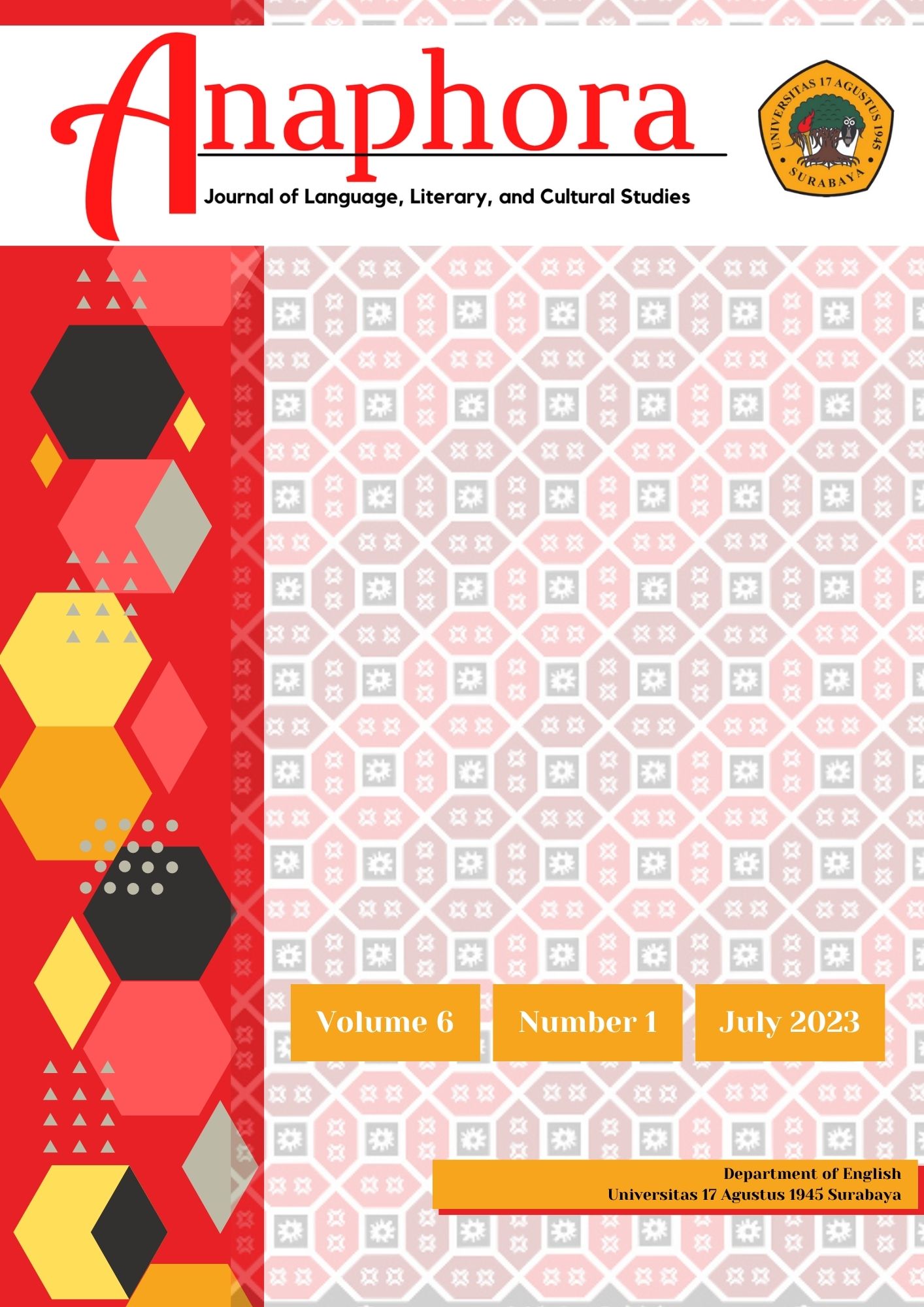Popularizing the Gay Characters: A Study of American Gay-Themed TV Series in 2000s
Abstract
This study is a qualitative research which concentrates on the rise of TV series gay characters on American televisions starting in the early 2000s. The emergence of gay TV series in 2000s has made this phenomena interesting as well as essential to discuss since American television in the pre 2000s era was not not open about the gay characters in television series. The data for this study were obtained through a literature review consisting of journal articles as well as books. This study intended to identify why gay-themed TV series appeared in the 2000s by applying Hall’s theory of representation as a way for analyzing. This research is useful to an additional reference for other researchers and to increase people’s understanding on the gay TV series phenomenon in the US. The research findings showed that there at least four representations explaining the reasons for the emergence of gay-themed TV series in America – the progress of science and knowledge, the strength of minority, the state support, and the new target consumers.
Downloads
References
Aberson, C. L., & Dora, J. (2003). Reactions to gay men: Contact and overcorrection in an employee selection simulation. Current Psychology, 22(164–174).
Adi, & Rohani, I. (2011). Fiksi Populer (Teori dan Metode Kajian). Pustaka Pelajar, 1(69).
Arthurs, J. (2004). Television and Sexuality: Regulation and the Politics of Taste. Open University Press.
Avila-Saavedra, G. (2009). Nothing queer about queer television: Televized construction of gay masculinities. Media, Culture and Society, 31(1). https://doi.org/10.1177/0163443708098243
Baim, T. (2013). Gay Press, Gay Power: The Growth of LGBT Community Newspapers in America. Journalism History, 29(2).
Becker, R. (2006). Gay TV and straight America. In Gay TV and Straight America. https://doi.org/10.1111/j.1540-5931.2007.00360.x
Benshoff, H. M. (2006). Queer Images: A History of Gay and Lesbian Film in America. Film & History: An Interdisciplinary Journal of Film and Television Studies, 36(2). https://doi.org/10.1353/flm.2006.0022
Bernstein, M. (2004). Paths to homophobia. Sexuality Research and Social Policy, 1(2). https://doi.org/10.1525/srsp.2004.1.2.41
Burns, K. (2005). A Constitutional Amendment Against Gay Marriage Is Necessary. In Gay Marriage. Green Haven Press.
Chasin, A. (2000). Selling out: the gay and lesbian movement goes to market. Choice Reviews Online, 38(02). https://doi.org/10.5860/choice.38-1011
Cummins, W., & Gordon, G. (2006). Programming Our Lives: Television and American Identity. Praeger .
D’Emilo, J. (2012). The Leading Edge of Change: The LGBT Press in the 1970s. In Tracy Baim (Ed.), Gay Press, Gay Power: The Growth of LGBT Community Newspaper in America. Prairie Avenue Productions and Windy City Media Group.
Eaklor, V. L. (2008). Queer America: An LGBT History of the 20th Century. Greenwood Press.
Fejes, F. (2008). Gay Rights Come to Miami. In Gay Rights and Moral Panic. https://doi.org/10.1057/9780230614680_3
Frost, T. (2015). The Promise of Liberty to All: The Long March to Marriage Equality. Liverpool Law Review, 36(2). https://doi.org/10.1007/s10991-015-9168-5
Gamson, J. (2014). The Intersection of Gay Street and Straight Street: Shopping, Social Class, and the New Gay Visibility. Social Thought and Research. https://doi.org/10.17161/str.1808.5208
Goltz, D. B. (2011). Queer temporalities in gay male representation: Tragedy, normativity, and futurity. In Queer Temporalities in Gay Male Representation: Tragedy, Normativity, and Futurity. https://doi.org/10.4324/9780203861318
Hall, S. (1997). Representation: Cultural Representations and signifying practices spectacle of the other. Sage Publication.
Hariwijaya, M., & Djaelani, B. M. (2004). Teknik Menulis Skripsi & Thesis. Zenith Publisher.
Harper, G. W., & Schneider, M. (2003). Oppression and discrimination among lesbian, gay, bisexual, and transgendered people and communities: A challenge for community psychology. American Journal of Community Psychology, 31(3–4). https://doi.org/10.1023/A:1023906620085
Henderson, L. (2007). Social issues in Television fiction. In Social Issues in Television Fiction. https://doi.org/10.1080/17405904.2011.558694
Herek, G. M. (2009). Sexual stigma and sexual prejudice in the United States: A conceptual framework. Nebraska Symposium on Motivation, 54. https://doi.org/10.1007/978-0-387-09556-1
Hudson, D. L. (2005). Gay Rights (A. Marzilli (Ed.)). Chelsea House.
Iborra, A. (2007). Dealing with homosexuality in a homophobic culture: A self-organization approach. Integrative Psychological and Behavioral Science, 41(3–4). https://doi.org/10.1007/s12124-007-9030-y
Jones, R., & Bego, M. (2009). Macho man : the disco era and gay America’s “coming out.”
Kingston, A. (2013). Respecting the contributions of LGBT Americans. New York : PowerKids Press.
Kooijman, J. (2008). Cruising the channels: The queerness of zapping. In Queer TV: Theories, Histories, Politics. https://doi.org/10.4324/9780203884225
Madon, S. (1997). What do people believe about gay males? A study of stereotype content and strength. Sex Roles, 37(9–10). https://doi.org/10.1007/BF02936334
Marcus, E. (2005). Is it a Choice? Answer to the Most Frequently Asked Questions about Gay and Lesbian People (3rd ed.). HarperOne.
McCarthy, A. (2001). Ellen: Making queer television history. Glq, 7(4), 593–620. https://doi.org/10.1215/10642684-7-4-593
Needham, G. (2008). Scheduling normativity: Television, the family, and queer Temporality. In Queer TV: Theories, Histories, Politics. https://doi.org/10.4324/9780203884225-14
Opalewski, K. (2012). Between The Lines. In T. Baim (Ed.), Gay Press, Gay Power: The Growth of LGBT Community Newspaper in America. Chicago, Illinois : Prairie Avenue Productions and Windy City Media Group.
Persell, C. H., Green, A., & Gurevich, L. (2001). Civil society, economic distress, and social tolerance. Sociological Forum, 16(2). https://doi.org/10.1023/A:1011048600902
Prono, L. (2008). Sources: Encyclopedia of Gay and Lesbian Popular Culture. Reference & User Services Quarterly, 48(1). https://doi.org/10.5860/rusq.48n1.90.2
Reed, J. (2007). The Three Phases of Ellen: From Queer to Gay to Postgay. In Queer Popular Culture. Palgrave Macmillan. https://doi.org/10.1057/9780230604384_2
Reumann, M. G. (2005). American sexual character: Sex, gender, and national identity in the Kinsey reports. In American Sexual Character: Sex, Gender, and National Identity in the Kinsey Reports. https://doi.org/10.1353/sex.2007.0007
Robinson, P. (2008). The Changing World of Gay Men. In The Changing World of Gay Men. https://doi.org/10.1057/9780230584310
Rohlinger, D. A. (2002). Eroticizing men: Cultural influences on advertising and male objectification. In Sex Roles (Vol. 46, Issues 3–4). https://doi.org/10.1023/A:1016575909173
Rudy, R. (2022). STRUGGLING AGAINST STEREOTYPE: A STUDY OF MASCULINITY IN AMERICAN GAY TV SERIES. Rubikon : Journal of Transnational American Studies, 9(1). https://doi.org/10.22146/rubikon.v9i1.72979
Rudy, R., & Adhitya, G. N. (2022). Fashioning The Gays: A Representation Study on the Gay Protagonists in the 2000s Gay-themed American TV Series. Journal of Language and Literature, 22(2). https://doi.org/10.24071/joll.v22i2.4667
Sander, K. (2005). Business, Not Politics: The Making of the Gay Market. Columbia University Press.
Schindel, J. E. (2008). Gender 101— beyond the binary: Gay-straight alliances and gender activism. Sexuality Research and Social Policy, 5(2). https://doi.org/10.1525/srsp.2008.5.2.56
Stewart, C. (2003). Gay and Lesbian Issues. ABC-CLIO.
Stotzer, R. L. (2009). Straight allies: Supportive attitudes toward lesbians, gay men, and bisexuals in a college sample. Sex Roles, 60(1–2). https://doi.org/10.1007/s11199-008-9508-1
Streitmatter, R. (2009). From ‘Perverts’ to ‘Fab Five’: The Media’s changing Depiction of Gay Men and Lesbians. Routledge.
Swank, E., Woodford, M. R., & Lim, C. (2013). Antecedents of pro-LGBT advocacy among sexual minority and heterosexual college students. Sexuality Research and Social Policy, 10(4). https://doi.org/10.1007/s13178-013-0136-3
Tully, C. T. (2000). Lesbian, Gays & the empowerment Perspective. Columbia University Press.
Wheeler-Quinnel, C. (2010). Marketing: How to Market to Gay Consumer. Stonewall Workplace Guides.
Whitley, B. E., & Ægisdóttir, S. (2000). The gender belief system, authoritarianism, social dominance orientation, and heterosexuals’ attitudes toward lesbians and gay men. Sex Roles, 42(11–12). https://doi.org/10.1023/A:1007026016001
Wood, P. (2003). Diversity in America. Society, 40, 60–68.
Zosuls, K. M., Miller, C. F., Ruble, D. N., Martin, C. L., & Fabes, R. A. (2011). Gender Development Research in Sex Roles: Historical Trends and Future Directions. In Sex Roles (Vol. 64, Issues 11–12). https://doi.org/10.1007/s11199-010-9902-3
Copyright (c) 2023 Rudy Rudy, Muhammad Kiki Wardana

This work is licensed under a Creative Commons Attribution-ShareAlike 4.0 International License.
Authors whose manuscript is published will approve the following provisions:
-
The right to publication of all journal material published on the jurnal anaphora website is held by the editorial board with the author's knowledge (moral rights remain the property of the author).
-
The formal legal provisions for access to digital articles of this electronic journal are subject to the terms of the Creative Commons Attribution-ShareAlike (CC BY-SA) license, which means Jurnal Persona reserves the right to store, modify the format, administer in database, maintain and publish articles without requesting permission from the Author as long as it keeps the Author's name as the owner of Copyright.
-
Printed and electronic published manuscripts are open access for educational, research and library purposes. In addition to these objectives, the editorial board shall not be liable for violations of copyright law.




